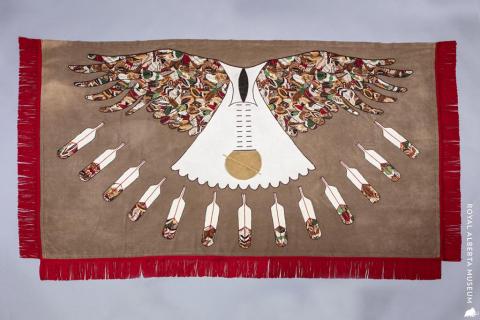Honour Songs
By Melissa-Jo Belcourt Moses, Métis Artist, and Emma Knight, Assistant Curator, Indigenous Studies
June 4, 2020

This week, we are featuring the work of Melissa-Jo (MJ) Belcourt Moses. MJ is a Métis artist of Cree, Mohawk and French heritage from Lac Ste. Anne, Alberta. She possesses a wealth of cultural knowledge. Her artwork includes porcupine quillwork, moose hair embroidery, caribou tufting, beadwork, embroidery, fish scale art and hide tanning to name a few. MJ gives credit to her elder, Elsie Quintal from Square Lake for teaching her many of the traditional methods.
In 2006, Melissa-Jo was invited to represent Alberta’ cultural heritage at the Smithsonian Folklife Festival in Washington, D.C. In 2009 she was the recipient of the Aboriginal Role Model of Alberta Art Award, and in 2019 she was the Indigenous Artist in Residence for the City of Edmonton. During her tenure, she focused on teaching young Indigenous women the traditional skills that were passed on to her.
We feel very fortunate to have worked with MJ for several years and you can see some of her work on display in our galleries. MJ made both the beaver hide and the stretched moose rawhide in the World’s Meet gallery using traditional techniques she learned from her elders. She is also featured in the Métis film called ‘Carrying on the Legacy’ in the What Makes Us Strong gallery. We are very lucky to have MJ’s ‘Honour Songs’ shawl in our permanent collection

About Honour Songs shawl:
“This 'story shawl' was made to honour indigenous women. As in ceremony or dance, a woman wears a shawl in respect of self and of those who share ceremony or dance. The two eagle wings represent the need for both man and woman to conceive a child. As eagles mate for life, both parents would nurture their offspring. So too a child flourishes when both parents provide love as the child grows. The 13 feathers represent the 13 moons in our yearly cycle, and as women we are honoured with our monthly moontime. I have been told in the Cree culture that the tipi represents the woman, as it resembles a dress with arms upward praising the creator of life, and it is through the tipi's doorway life emerges.”
-Melissa-Jo Belcourt Moses